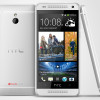Review: HTC One mini
Screen
The screen is one area where HTC had to pull back a bit in order to create the mini. Since the entire point of the mini is to provide consumers with a smaller premium phone, HTC reduced the size of the screen from the One's 4.7 inches to 4.3 inches for the mini. This may not sound like a lot, but the effect on the mini's size is what makes it so great to use. Does a smaller screen make for a lesser experience, though? Not really. The resolution is 720p, which is the current best available at 4.3 inches. Everything on the mini's screen is smaller, but just as crisp and sharp. Edges are smooth and my eyes couldn't spot any individual pixels anywhere. The mini's Super LCD screen is bright and colorful, and every bit as usable outdoors as the One's. It's a fine display.
Signal
HTC lent us an unlocked international version of the mini. Though we used it on AT&T's network, it is not optimized for AT&T, nor does it support AT&T's LTE 4G network. That said, it easily latched onto AT&T's HSPA+ signal and offered excellent performance throughout the NYC region. I used the phone up and down the coast of NJ as well as in NYC and it always provided a connection. Calls always connected on the first dial. and the mini didn't drop nor miss any calls. Data speeds were limited a little bit by the mini's lack of optimization for AT&T's network, but were still good enough to handle my needs for the week. In areas where coverage was weak, the mini was a reliable performer.
Sound
Again, allowing for the fact that our review unit has not been optimized for AT&T's network, calls sounded quite good. The quality was a little thin and sharp to my ears, but that meant voices coming through the earpiece cut through background noise. It helps that the speakers can pump out a significant amount of volume. I was easily able to hold conversations when walking down busy city streets or hanging out in a noisy coffee shop. People with whom I spoke didn't have any complaints about the quality of my voice. The speakerphone works particularly well, thanks to the front-facing speaker setup of the mini. Calls could be cranked up to fill a large meeting room with enough sound, let alone smaller spaces, such as your kitchen or living room. The quality of calls coming from the speakerphone was good, though I noticed a slight increase in interference.
The mini's ringers and alert tones are ridiculously loud. The BoomSound speakers work wonders when it comes to getting your attention from afar. It is one of the louder phones I've tested, second perhaps only to the One itself. Further, the klaxon-like ringtones, buzzers and beeps create enough havoc to make you come running. The vibrate alert is good, but could be a little bit better. I missed several text messages, for example, because I didn't feel the vibrate alert when walking around NYC.
Battery
With the smaller, less pixel-rich screen and lower-power processor under the hood, the mini is able to provide a full day of battery life — as long as you manage it correctly. I had no trouble using the mini all day long with minimial use, though it was close to empty by the time I went to bed. (It's worth pointing out that the HTC First has the same screen/processor setup and did not have great battery life.) Remember, however, that we did not test the mini on an LTE network. If you find yourself running into trouble midway through the day, it's worth pointing out that the mini has a power-saver mode that conserves power. The power saver ramps down CPU output, lowers brightness of the display, turns off vibrate alerts, and turns off the data radio connection when the screen is off. Together, these make for huge power savings. You can choose to activate any or all of these options.


 Hands-On: HTC Desire 601 and Accessories
Hands-On: HTC Desire 601 and Accessories
 Hands On with the HTC One mini
Hands On with the HTC One mini
 HTC One mini Hits AT&T Stores August 23 for $99
HTC One mini Hits AT&T Stores August 23 for $99
 HTC One Mini Made with the Small-Handed in Mind
HTC One Mini Made with the Small-Handed in Mind
 HTC One mini
HTC One mini









